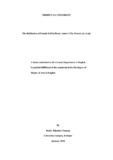Please use this identifier to cite or link to this item:
https://elibrary.tucl.edu.np/handle/123456789/3282Full metadata record
| DC Field | Value | Language |
|---|---|---|
| dc.contributor.author | Tamang, Badri Bahadur | |
| dc.date.accessioned | 2018-03-21T05:11:36Z | |
| dc.date.accessioned | 2021-07-23T04:34:45Z | - |
| dc.date.available | 2018-03-21T05:11:36Z | |
| dc.date.available | 2021-07-23T04:34:45Z | - |
| dc.date.issued | 2010 | |
| dc.identifier.uri | http://elibrary.tucl.edu.np/handle/123456789/3282 | - |
| dc.description.abstract | Isabel’s commoditization begins when she falls in love with and marries the sinister Gilberr Osmond, who wants her only for her money and who her treats as an object, almost part of his art collection. Osmond regards her from the point of view of her exchange and sign exchange value. The novel’s central attraction lies at the ownership of human beings. The ownership does not mean the literal possession of a man or a woman but rather the denial or suppression of another’s autonomy by using that person for purposes of one’s own. Understood in this way, proprietorship in persons is the constitutive element of social relations generally as they are portrayed in the novel Contents. | en_US |
| dc.language.iso | en_US | en_US |
| dc.publisher | Central Department of English Kirtipur, Kathmandu | en_US |
| dc.subject | Engish literature | en_US |
| dc.subject | Independent | en_US |
| dc.title | The Reification of Female Self in Henry James’s The Portrait of a Lady | en_US |
| dc.type | Thesis | en_US |
| Appears in Collections: | English | |
Files in This Item:
| File | Description | Size | Format | |
|---|---|---|---|---|
| 6022pdf.pdf | 428.78 kB | Adobe PDF |  View/Open |
Items in DSpace are protected by copyright, with all rights reserved, unless otherwise indicated.
